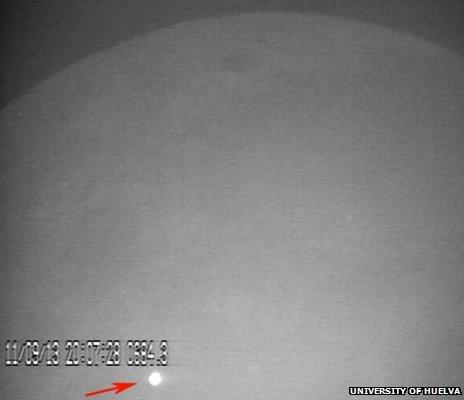'Biggest observed meteorite impact' hits Moon
- Published

The impact appeared as a bright white flash on 11 September 2013
Scientists say they have observed a record-breaking impact on the Moon.
Spanish astronomers spotted a meteorite with a mass of about half a tonne crashing into the lunar surface last September.
They say the collision would have generated a flash of light so bright that it would have been visible from Earth.
The event is reported in the Monthly Notices of the Royal Astronomical Society, external.
"This is the largest, brightest impact we have ever observed on the Moon," said Prof Jose Madiedo, of the University of Huelva in south-western Spain.
The explosive strike was spotted by the Moon Impacts Detection and Analysis System (Midas) of telescopes in southern Spain on 11 September at 20:07 GMT.
"Usually lunar impacts have a very short duration - just a fraction of a second. But the impact we detected lasted over eight seconds. It was almost as bright as the Pole Star, which makes it the brightest impact event that we have recorded from Earth," said Prof Madiedo.
The researchers say a lump of rock weighing about 400kg (900lb) and travelling at 61,000km/h (38,000mph) slammed into the surface of the Moon.
They believe the dense mass, which had a width of 0.6-1.4m (2-4.6ft), hit with energy equivalent to about 15 tonnes of TNT.
This is about three times more explosive than another lunar impact spotted by Nasa last March. That space rock weighed about 40kg and was about 0.3-0.4m wide.
Scarred Moon
The team believes the impact has left behind a 40m-wide crater.
"That's the estimation we have made according to current impact models. We expect that soon Nasa could observe the crater and confirm our prediction," said Prof Madiedo.
It would be one of many scars on the lunar surface.
Unlike Earth, the Moon has no atmosphere to shield it from meteorite collisions, and its surface shows a record of every strike.
The researchers believe that impacts from rocks of about 1m in diameter could be far more common than was previously thought - both on the Moon and on Earth.
However, most rocks of this size would burn up as they entered the Earth's atmosphere, appearing as a fireball in the sky.
For meteorites to make more of an impact here, they need to be larger.
For example, the asteroid that exploded over Chelyabinsk in Russia on 15 February 2013 was estimated to be about 19m wide.
It hit the atmosphere with energy estimated to be equivalent to 500,000 tonnes of TNT, sending a shockwave twice around the globe. It caused widespread damage and injured more than 1,000 people.
Follow Rebecca on Twitter, external
- Published3 January 2013
- Published14 June 2010
- Published6 November 2013